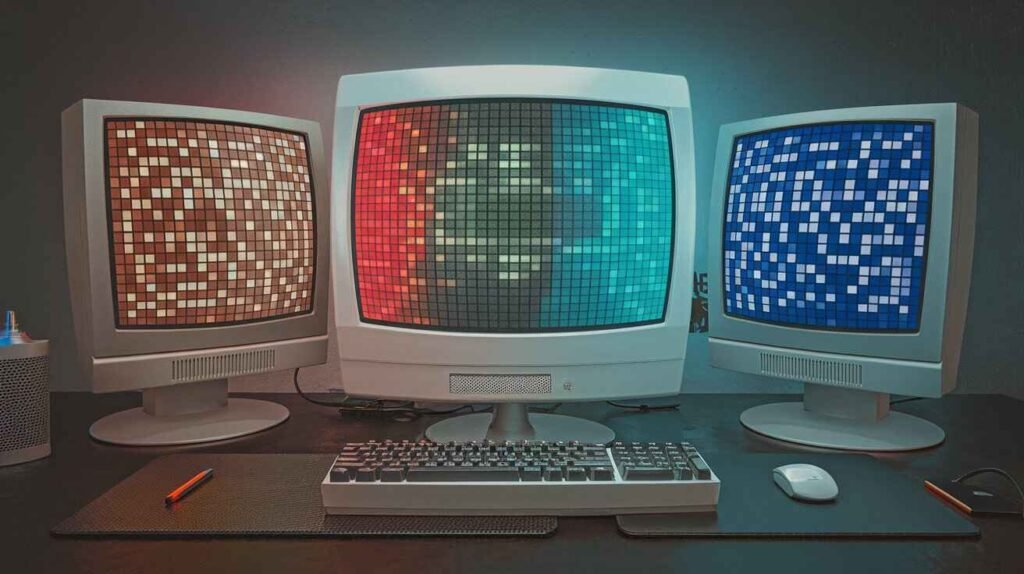CRT filters are utilized in various video games, emulators, and applications to replicate the look of older CRT monitors. These filters simulate awesome traits of CRT shows, including scanlines, phosphor glow, and colour bleeding. While beautifying the visible reveal, they also require huge GPU power to render those results. In this text, we are able to discover in element why CRT filters are so stressful on GPU overall performance, how they paint, and the strategies you could use to optimize them for better overall performance without losing visual best.
Understanding CRT Filters and Their Impact on GPU Performance
CRT filters are designed to recreate the nostalgic feel of vintage CRT monitors on contemporary displays. They often use shaders to simulate visual results like scanlines, colour bleed, and phosphor glow. These filters are implemented in real time, so the GPU should constantly process and adjust pixel values for every animation or gameplay.
While the consequences they simulate are visually appealing, they extensively increase the computational load on your GPU. Let’s dive deeper into the key components of CRT filters and how they contribute to the excessive GPU demands.
Key Components of CRT Filters
CRT filters simulate several specific houses of CRT displays:
- Scanlines: Horizontal lines that appear on older CRT displays because of the scanning electron beams. This effect requires the GPU to manipulate pixel brightness primarily based on its function relative to the scanline.
- Phosphor Glow: The smooth, diffused glow of pixels on a CRT display. This is simulated with the aid of complicated algorithms that alter pixel brightness to mimic the natural light.
- Colour Bleeding: In a CRT show, colourings occasionally blend or bleed into adjoining pixels, creating a softer, sometimes extra vibrant appearance. This phenomenon needs recalculating for every pixel in real-time.
- Screen Curvature: CRT video display units are curved, which distorts the photo in a selected manner. The GPU needs to simulate this curvature sensibly by applying geometric transformations to each frame.
Each result requires constant calculations, and the more unique the simulation, the higher the GPU calls for.
Why Do CRT Filters Consume So Much GPU Power?
There are several reasons why CRT filters greatly burden GPU performance. From real-time calculations to the need for high-decision rendering, these filters require a tremendous amount of GPU resources. Let’s explore the motives for this excessive electricity consumption.
Real-Time Pixel Manipulation
CRT filters simulate visible consequences like scanlines and phosphor glow by manipulating pixels in real time. For each frame of animation or gameplay, the GPU ought to calculate and modify every pixel based on its role and the effect being implemented.
For example:
- Scanlines: The GPU needs to examine every pixel’s function in the scanline sample and adjust its brightness accordingly. This requires calculating pixel colourings and using the scanline pattern dynamically.
- Phosphor Glow: To simulate the glow from phosphor debris, the GPU should modify the light diffusion between adjacent pixels, recalculating their brightness in real time.
Each of these consequences needs to be processed frame-by-means of the frame, which will increase the weight on the GPU.
Higher Resolutions and Refresh Rates Increase Power Consumption
As screen resolutions boom, so does the variety of pixels that need to be manipulated. For instance, a 4K resolution has over eight million pixels, compared to 2 million pixels at 1080p. This exponential increase in pixel dependence means that the GPU ought to perform many greater calculations to apply the CRT filter-out outcomes. Additionally, higher refresh charges increase the range of frames that need to be processed per second.
At higher resolutions (e.g., 4K or better) and refresh rates (e.g., 144Hz or 240Hz), the GPU needs to constantly manage extra facts, which amplifies the general power consumption required to render these CRT outputs.
Impact of Scanlines and Color Bleeding on GPU Load
Scanlines: Why They Are GPU-Intensive
Scanlines are among the most computationally expensive elements of CRT filters. To simulate scanlines, the GPU should adjust the colour and brightness of pixels based on their position in a scanline sample. The higher the decision, the more scanlines the GPU wishes to process.
At high resolutions, such as 1440p or 4K, the GPU needs to cope with substantially greater scanline calculations. Even small adjustments to the scanline density can drastically increase the wide variety of pixels being processed, inflicting greater electricity intake.
Colour Bleeding and Its Computational Demand
Simulating shade bleeding is another aspect that will increase GPU load. This phenomenon happens when adjacent hues bleed into each other due to the traits of the phosphor material on CRT screens. To reflect this impact, the GPU needs to continuously adjust pixel values primarily based on their colour proximity, growing a subtle combination between adjoining colourations.
This impact calls for regular recalculations for every frame and pixel, contributing extensively to GPU strength intake. As higher screen resolutions provide more pixels to regulate, the computational needs for correct shade mixing boom.
Also Checkout: How Much Does a PC Cost? Your Easy Guide to Building the Best Setup
Impact of Higher Resolutions and Refresh Rates on GPU Load
The computational needs of CRT filters become exponentially more severe while running at higher screen resolutions and refresh prices.
Resolution
At higher resolutions (e.g., 4K), the GPU ought to process far more pixels. For instance, a 4K screen has over 8 million pixels, compared to 2 million on a 1080p show. Applying CRT consequences like scanlines and phosphor glow to this large range of pixels requires extra GPU power.
Refresh Rates
High refresh prices (e.g., 144Hz or 240Hz) also put additional pressure on the GPU. For every 2d, the GPU ought to process extra frames, which means extra recalculations of the CRT filter outcomes in step with second, increasing energy utilization.
| Resolution | Number of Pixels | Effect on GPU Load |
| 1080p (Full HD) | 2,073,600 | Lower GPU load |
| 1440p (Quad HD) | 3,686,400 | Moderate GPU load |
| 4K (Ultra HD) | 8,294,400 | High GPU load |

Phosphor Glow and Screen Curvature: Additional Factors in GPU Load
Simulating Phosphor Glow
The phosphor glow effect simulates the way light diffuses on CRT monitors. The GPU needs to modify the brightness and glow of pixels based totally on their proximity to different pixels and their colouration intensity. This impact isn’t only an easy brightness adjustment—it involves complex algorithms that make the glow seem clean and herbal.
As a result, the GPU needs to calculate this glow effect for each pixel in real-time, requiring great computational energy. This is especially true when applied at excessive resolutions or in eventualities with fast-shifting elements.
Simulating Screen Curvature
Simulating the curvature of CRT screens is another element that calls for large GPU resources. Unlike flat-panel presentations, CRT monitors have a natural curvature that affects how pictures are displayed. To mirror this impact, the GPU wishes to use geometric modifications to every frame, adjusting pixel positions in step with the curvature of the display screen.
This requires the GPU to perform real-time picture warping for each frame, which is computationally expensive—the more complicated the curvature impact, the better the GPU’s electricity intake.
Optimizing CRT Filters for Better GPU Performance
While CRT filters are computationally demanding, several optimization techniques can lessen their effect on GPU overall performance without sacrificing visible best. Below are some methods to help you manage GPU load effectively.
Lower the Internal Resolution of CRT Effects
Many emulators and programs allow users to regulate the internal decision at which CRT outcomes are implemented. By lowering this resolution, you reduce the number of pixels that the GPU must process for each impact, which simultaneously reduces GPU load. For example, instead of applying CRT filters at 4K, you can apply them at a lower resolution like 1080p, saving widespread electricity while nonetheless accomplishing an excellent visual effect.
Choose Lighter Shaders for CRT Effects
Some CRT filters have exclusive shader alternatives that balance high quality and overall performance. Opting for lighter shaders can lessen computational needs. For example, certain CRT shaders simulate scanlines and glow with fewer elements, resulting in fewer GPU calculations according to the body.
Types of Lighter Shaders
- Basic Scanline Shaders: Apply less complicated styles of scanlines with much less version.
- Simplified Glow Shaders: Simulate phosphor glow with reduced intensity and fewer colouration modifications.
These shaders allow customers to enjoy the retro effect without the heavy GPU demands.
Upgrade Your Hardware for Better Performance
If you often use CRT filters and have overall performance troubles, upgrading your hardware can be vital. Modern high-stop GPUs and NVIDIA’s RTX or AMD’s Radeon RX collection can cope more efficiently with more complicated shaders and better resolutions. Additionally, quicker CPUs with extra cores can help alleviate some of the processing burdens on the GPU by enhancing average system performance during frame rendering.
Practical Tips for Managing GPU Load
Here are a few practical steps you may take to lessen the GPU load while the use of CRT filters:
- Use CRT Filter Presets: Many retro gaming packages offer preset CRT clear-out options that stabilize performance and visual fidelity. These presets let you quickly transfer between distinct stages of detail.
- Enable V-Sync: V-Sync facilitates limiting your body charge, reducing the number of frames that need to be processed by the GPU. This can help minimize the GPU load for the duration of gameplay.
- Monitor GPU Performance: Use overall performance monitoring gear like MSI Afterburner to record GPU temperature, utilization, and strength intake. This will help you become aware of bottlenecks and make necessary changes to optimize performance.
Conclusion: Optimizing the Use of CRT Filters While Reducing GPU Load
CRT filters enhance visibility by simulating the nostalgic appearance of antique CRT displays. However, they’re noticeably annoying on GPU strength because of the actual-time pixel manipulation, excessive-resolution rendering, and complex consequences like scanlines, phosphor glow, and display curvature. By being knowledgeable about why those filters devour so much GPU power, you can take steps to optimize their usage and visual stability with overall performance.
Key Takeaways
- High computational calls for CRT filters require real-time pixel modifications, simulating complex results like scanlines and glow.
- Impact of decision and refresh rates: Higher resolutions and refresh prices drastically increase computational load.
- Optimization techniques: Lowering internal decisions, using lighter shaders, and upgrading hardware are powerful techniques for optimizing overall performance.
By applying those techniques, you could continue to enjoy the visible attraction of CRT filters while minimizing their effect on GPU performance.
FAQs
Why do CRT filters use a lot of GPU strength?
CRT filters require actual-time pixel modifications to simulate outcomes like scanlines, phosphor glow, and colouration bleeding. These filters require extensive calculations through the GPU for each frame.
Do better resolutions make CRT filters extra disturbing?
Higher resolutions like 4K increase the range of pixels processed, leading to extra computational load for consequences like scanlines and colouration blending.
Can CRT filters be optimized for better GPU performance?
Absolutely! You can decrease the decision, use lighter shaders, and enable performance-friendly presets to reduce GPU load while preserving retro visuals.
Are cutting-edge GPUs better at coping with CRT filters?
Currently, GPUs like the NVIDIA RTX or AMD Radeon RX series deal with complex CRT shaders more correctly, making them best for high-resolution, unfashionable gaming.
What’s the satisfactory manner to balance CRT clear-out visuals and GPU performance?
Using optimized settings, such as lowering filter out depth or choosing simplified shaders, permits you to revel in beautiful visuals while decreasing strain on your GPU.
Also Read: How Do Motherboards Work Tech Quickie? The Essential Guide for 2024





